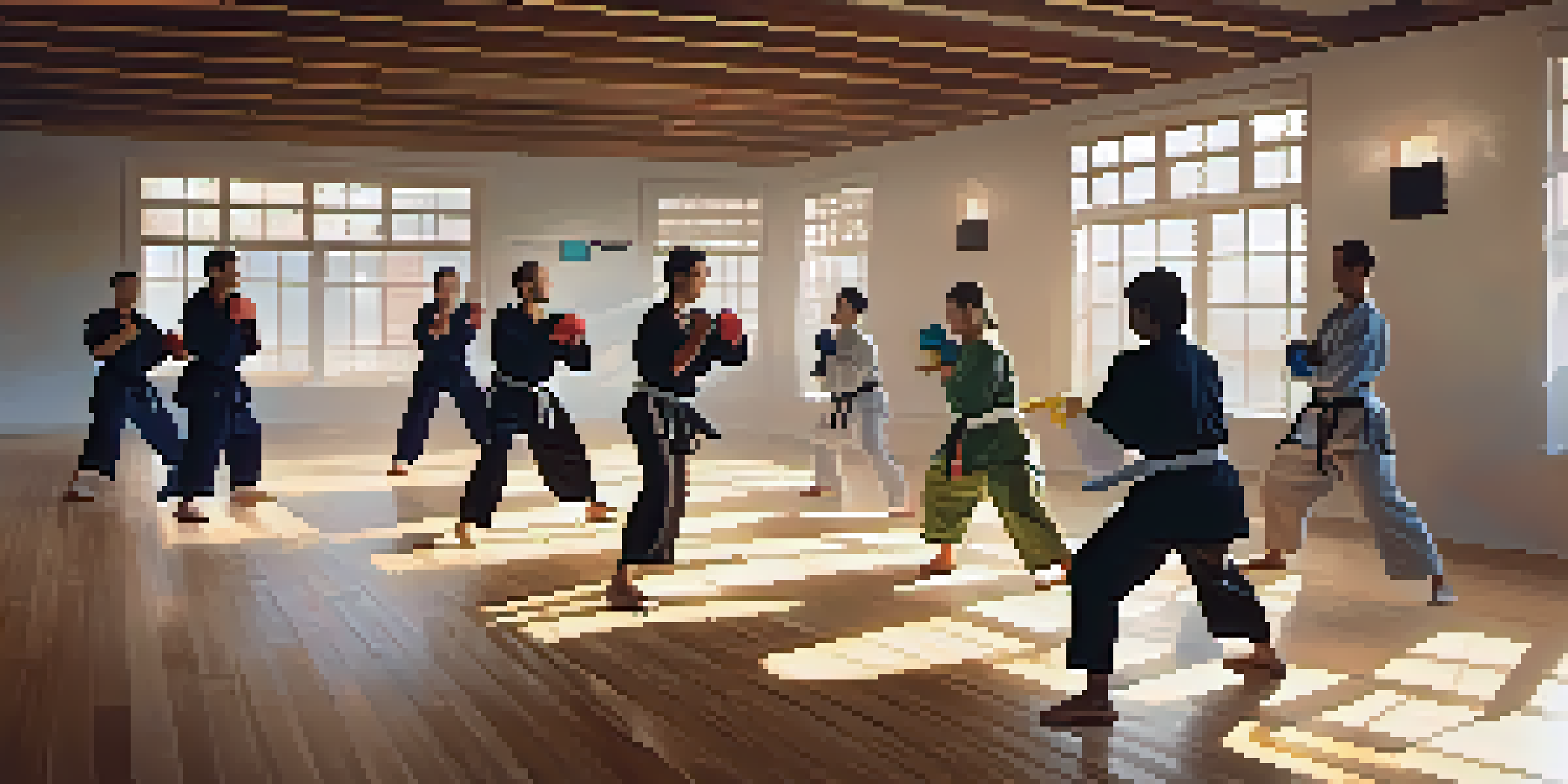Techniques for Managing Emotions During Self Defense Training

Understanding the Emotional Landscape of Self-Defense Training
Self-defense training can stir up a mix of emotions, from fear to excitement. Understanding these emotional responses is the first step toward managing them effectively. Just like a storm can be both thrilling and intimidating, the emotions tied to self-defense can be powerful and unpredictable.
Fear is not the enemy. It’s a signal. It’s a chance to stretch yourself and move beyond your comfort zone.
Recognizing your feelings during training sessions allows you to process them constructively. For instance, feeling anxious about sparring with a partner can be normal—acknowledging that anxiety is crucial. This awareness helps you to not only confront your emotions but also harness them to improve your focus and performance.
By embracing this emotional landscape, you cultivate resilience. Just as a seasoned traveler learns to navigate different terrains, you can learn to navigate your emotions, transforming fear into motivation and uncertainty into confidence.
Breathing Techniques to Ground Your Emotions
Deep breathing is a simple yet powerful technique to manage emotions during training. This method is akin to hitting the 'pause' button—allowing you to take a moment to center yourself. By inhaling deeply and exhaling slowly, you signal your body to relax, which can help ease anxiety before a challenging drill.

Practicing breathing exercises before and during training helps create a sense of control. Imagine standing on the edge of a diving board, feeling nervous; focused breathing can help you take that leap with confidence. This technique not only calms your nerves but also enhances your focus, allowing you to respond more effectively in training scenarios.
Emotions Are Key in Self-Defense
Understanding and managing your emotions during self-defense training enhances focus and resilience.
Incorporating breathing techniques into your routine transforms how you handle emotional spikes. Much like a calming wave, controlled breathing can wash away tension, making your training experience more enjoyable and productive.
Visualization Techniques for Emotional Preparation
Visualization is a powerful tool used by athletes across various disciplines. By picturing yourself successfully executing a self-defense move, you can calm nerves and build confidence. This mental rehearsal works like a dress rehearsal before a big show, helping you feel prepared and ready.
The only limit to our realization of tomorrow will be our doubts of today.
Before a training session, take a few moments to visualize the scenarios you might encounter. Imagine yourself responding calmly and effectively, much like a well-rehearsed performer delivering a flawless performance. This technique not only prepares your body but also primes your mind to respond positively under pressure.
The beauty of visualization lies in its ability to reshape your emotional responses. Just as a painter envisions their masterpiece before touching the canvas, you can create an emotional blueprint for success in self-defense training.
Mindfulness Practices to Enhance Emotional Awareness
Mindfulness encourages you to stay present and aware of your thoughts and feelings. Engaging in mindfulness practices during self-defense training can help you notice emotional shifts without judgment. Think of it like observing clouds passing in the sky, allowing you to acknowledge your feelings without being overwhelmed by them.
By incorporating mindfulness techniques, such as focusing on your breath or grounding yourself in the moment, you can better manage stress and anxiety. This practice creates a mental space where you can respond thoughtfully rather than react impulsively. It's about finding balance, just like a tightrope walker skillfully navigating their way across a line.
Breathing Techniques Calm Nerves
Deep breathing exercises help ground your emotions and can boost confidence before challenging drills.
Cultivating mindfulness enhances emotional regulation, leading to improved self-defense skills. As you become more attuned to your emotions, you can respond to challenges with greater clarity and poise.
Setting Realistic Goals for Emotional Growth
Setting realistic and achievable goals is crucial in self-defense training. Rather than aiming for perfection, focus on incremental progress, like climbing a staircase one step at a time. These small victories help build confidence and reduce feelings of inadequacy that can arise during training.
For instance, instead of striving to master a complex move in one session, aim to improve a basic technique. This approach not only makes training more manageable but also allows you to celebrate each achievement, fostering a positive emotional state. Just as a gardener nurtures their plants, you can cultivate your emotional growth through patience and persistence.
By setting realistic goals, you create a supportive environment for emotional development. This strategy empowers you to face challenges with resilience, transforming potential setbacks into opportunities for growth.
Building a Supportive Community for Emotional Well-Being
Having a supportive community can significantly impact your emotional well-being during self-defense training. Surrounding yourself with like-minded individuals who share similar goals creates a sense of camaraderie. It’s like joining a team where everyone encourages each other to grow and improve.
Sharing experiences and emotions with fellow students can lighten the emotional load. Whether it’s celebrating achievements or discussing fears, this open dialogue fosters connection and understanding. Think of it as a group of friends hiking together, where everyone supports each other through the tough parts of the trail.
Supportive Community Builds Strength
Being part of a supportive group fosters emotional well-being and encourages personal growth in training.
Building these connections not only enhances your training experience but also helps you develop emotional resilience. A supportive community serves as a safety net, allowing you to take risks and explore your capabilities without the fear of judgment.
Recognizing and Managing Fear During Training
Fear is a natural response when engaging in self-defense training, especially when faced with new techniques or sparring. Acknowledging that fear is a normal part of the process is the first step to managing it effectively. Think of it as a signal, like a warning light in your car, indicating that you need to pay attention to your emotions.
Instead of avoiding fear, confront it head-on by analyzing what triggers it. Is it the fear of failure, or perhaps the fear of physical confrontation? By understanding these triggers, you can develop strategies to address them, much like a detective solving a mystery.

Learning to manage fear not only enhances your training experience but also builds confidence. As you face your fears, you’ll find they often hold less power than you initially thought, allowing you to train with greater freedom and intention.